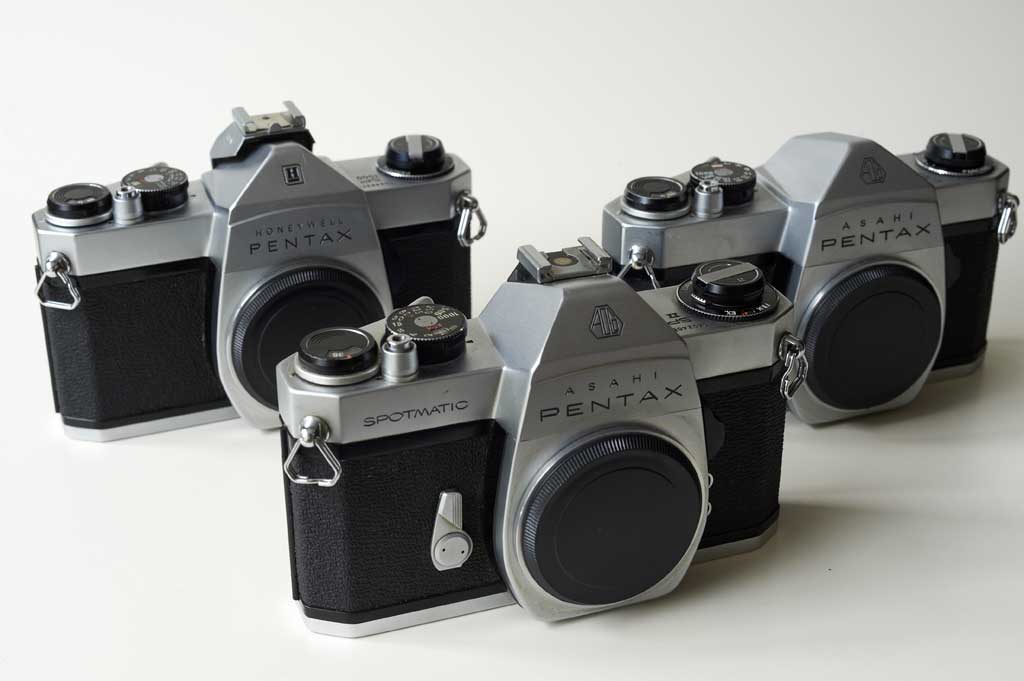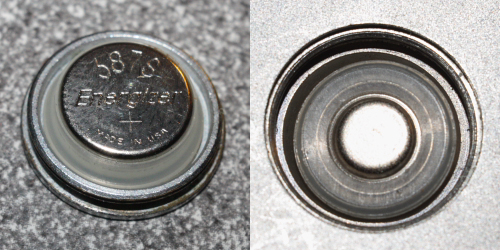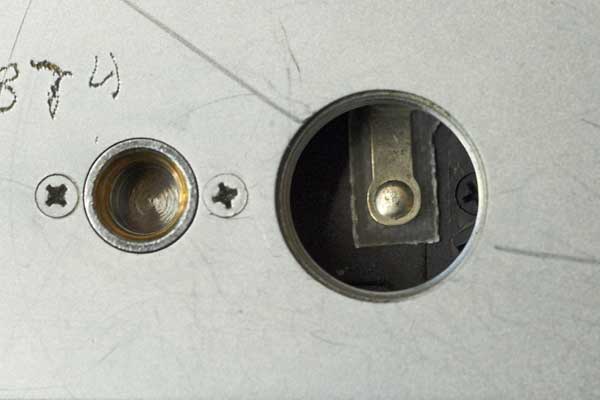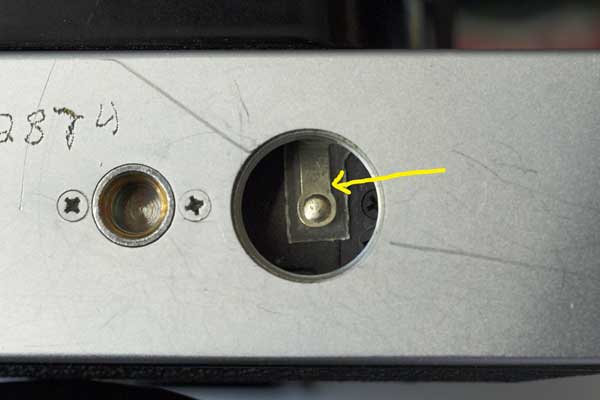| View previous topic :: View next topic |
| Author |
Message |
koji


Joined: 21 Jul 2008
Posts: 2107
Location: Hiroshima, Japan
Expire: 2012-12-27
|
 Posted: Wed Jul 27, 2011 7:29 pm Post subject: 3 PENTAX SPs Posted: Wed Jul 27, 2011 7:29 pm Post subject: 3 PENTAX SPs |
 |
|
koji wrote:
I bought these AS-IS PENTAX SPs in order to get a battery hole cover for
PENTAX KM which does not have one, a gift from my friend. All of them together
cost only Cdn $5.00, though shipping and tax in Ontario was $20! uugghh  

This is not really "equipment gallery" per se. I just wanted a battery hole
cover, but ALAS their battery cover does not fit into my PENTAX KM!!!!
So I ended up having three new PENTAXs, which I do not need now.
Luckily ASAHI SP1000 works perfectly, HANEYWELL SP1000 has black
spot in its finder but works. ASAHI SPII (Spotmatic)'s mirror occasionally
does not return, but seems fixable (since holding it in the vertical position
wont have this problem ?!?!). Of course they all need a 1.35v battery to
its meter to work.
Just for a laugh....  
_________________
Our Home Page has 18,200 photos in 575 directories today.
Lenses: https://www.pbase.com/kkawakami/top_level_my_lenses
Last edited by koji on Thu Jul 28, 2011 12:09 am; edited 1 time in total |
|
| Back to top |
|
 |
Attila


Joined: 24 Feb 2007
Posts: 57865
Location: Hungary
Expire: 2025-11-18
|
 Posted: Wed Jul 27, 2011 7:45 pm Post subject: Posted: Wed Jul 27, 2011 7:45 pm Post subject: |
 |
|
Attila wrote:
 New camera always fun, try them , perhaps you will like them. New camera always fun, try them , perhaps you will like them.
_________________
-------------------------------
Items on sale on Ebay
Sony NEX-7 Carl Zeiss Planar 85mm f1.4, Minolta MD 35mm f1.8, Konica 135mm f2.5, Minolta MD 50mm f1.2, Minolta MD 250mm f5.6, Carl Zeiss Sonnar 180mm f2.8
|
|
| Back to top |
|
 |
David

Joined: 13 Apr 2011
Posts: 1869
Location: Denver, Colorado
Expire: 2013-01-25
|
 Posted: Wed Jul 27, 2011 11:39 pm Post subject: Posted: Wed Jul 27, 2011 11:39 pm Post subject: |
 |
|
David wrote:
Those old spotmatics are good, reliable cameras. Mechanically simple and fairly reliable, they're likely to be mechanically sound still. The only question is if the light meters still work. I forget how the spotmatic's operates. If it's like the later K series cameras (namely the K1000), then it's possible for it to wear out over time, but not overly likely. I've never encountered a K1000 with a dead light meter, unlike many Nikons, Hanimexes, and other makes.
_________________
http://www.youtube.com/user/hancockDavidM |
|
| Back to top |
|
 |
koji


Joined: 21 Jul 2008
Posts: 2107
Location: Hiroshima, Japan
Expire: 2012-12-27
|
 Posted: Thu Jul 28, 2011 12:06 am Post subject: Posted: Thu Jul 28, 2011 12:06 am Post subject: |
 |
|
koji wrote:
| David wrote: |
| Those old spotmatics are good, reliable cameras. Mechanically simple and fairly reliable, they're likely to be mechanically sound still. The only question is if the light meters still work. I forget how the spotmatic's operates. If it's like the later K series cameras (namely the K1000), then it's possible for it to wear out over time, but not overly likely. I've never encountered a K1000 with a dead light meter, unlike many Nikons, Hanimexes, and other makes. |
I have checked one of SP1000s, its meter worked. ALthough I used SR44
battery so its value may not be accurate. Those cameras have v400PX
(1.35v) adapter (plastic holder) inside of its battery hole, I took this plastic
holder so that I can put an SR44. I have no idea this plastic insert is
after thought modification by ASAHI PENTAX or not. I should've made
a photo of it in here. If I have a genuine 1.35v battery, they would work,
though it is not important for me.
_________________
Our Home Page has 18,200 photos in 575 directories today.
Lenses: https://www.pbase.com/kkawakami/top_level_my_lenses |
|
| Back to top |
|
 |
martinsmith99


Joined: 31 Aug 2008
Posts: 6950
Location: S Glos, UK
Expire: 2013-11-18
|
 Posted: Thu Jul 28, 2011 6:12 am Post subject: Posted: Thu Jul 28, 2011 6:12 am Post subject: |
 |
|
martinsmith99 wrote:
I have 3 SPiis: The 1st one I bought with as part of a kit, the 2nd as it was pristine and the 3rd as it was black.
The mirror return can be fixed easily by removing the bottom plate. You'll see the problem when it happens.
_________________
Casual attendance these days |
|
| Back to top |
|
 |
Nesster


Joined: 24 Apr 2008
Posts: 5883
Location: NJ, USA
Expire: 2014-02-20
|
 Posted: Thu Jul 28, 2011 10:33 am Post subject: Posted: Thu Jul 28, 2011 10:33 am Post subject: |
 |
|
Nesster wrote:
I really like the SP1000... all the meters work fine with modern batteries, at least that's my finding and the general consensus around the net. Of course there's always someone with a contrary example  or warning... Pentax used a bridge circuit so they are not sensitive to battery voltage. or warning... Pentax used a bridge circuit so they are not sensitive to battery voltage.
_________________
-Jussi
Camera photos
Print Photographica
|
|
| Back to top |
|
 |
koji


Joined: 21 Jul 2008
Posts: 2107
Location: Hiroshima, Japan
Expire: 2012-12-27
|
 Posted: Thu Jul 28, 2011 11:33 am Post subject: Posted: Thu Jul 28, 2011 11:33 am Post subject: |
 |
|
koji wrote:
Great news Martin and Jussi.
I will try to fix the mirror problem of SPII, thanks.
So I can use LR44 or Sr44, eh. Will check its accuracy myself.
------------
I have fixed the mirror problem of SPII, but its meter seems dead.
(One of mechanical lever has to be bend a little to hit another lever.)
The other two SP1000's meters seem to work, checked with dSLRs
meters they look OK. 
_________________
Our Home Page has 18,200 photos in 575 directories today.
Lenses: https://www.pbase.com/kkawakami/top_level_my_lenses |
|
| Back to top |
|
 |
martinsmith99


Joined: 31 Aug 2008
Posts: 6950
Location: S Glos, UK
Expire: 2013-11-18
|
 Posted: Thu Jul 28, 2011 8:05 pm Post subject: Posted: Thu Jul 28, 2011 8:05 pm Post subject: |
 |
|
martinsmith99 wrote:
| koji wrote: |
Great news Martin and Jussi.
I will try to fix the mirror problem of SPII, thanks.
So I can use LR44 or Sr44, eh. Will check its accuracy myself.
------------
I have fixed the mirror problem of SPII, but its meter seems dead.
(One of mechanical lever has to be bend a little to hit another lever.)
The other two SP1000's meters seem to work, checked with dSLRs
meters they look OK.  |
I found a little difference when using an adapter to correct the voltage and not on all bodies. If using print film, don't worry as it's not enough to make a difference and usually in very low light.
_________________
Casual attendance these days |
|
| Back to top |
|
 |
peterqd


Joined: 28 Feb 2007
Posts: 7448
Location: near High Wycombe, UK
Expire: 2014-01-04
|
 Posted: Thu Jul 28, 2011 9:40 pm Post subject: Posted: Thu Jul 28, 2011 9:40 pm Post subject: |
 |
|
peterqd wrote:
| koji wrote: |
Great news Martin and Jussi.
I will try to fix the mirror problem of SPII, thanks.
So I can use LR44 or Sr44, eh. Will check its accuracy myself. |
You'll find that LR/SR44 batteries are too fat to fit inside the SP battery compartment, koji. You can use a Weincell or a hearing aid battery for the right voltage, but the output voltage is variable and they fade quickly (whether or not you use the camera). The correct silver oxide battery to fit properly is the Energizer 387S, also used for Accutron watches. It's thinner and has a plastic insulating collar.

_________________
Peter - Moderator |
|
| Back to top |
|
 |
koji


Joined: 21 Jul 2008
Posts: 2107
Location: Hiroshima, Japan
Expire: 2012-12-27
|
 Posted: Fri Jul 29, 2011 9:04 pm Post subject: Posted: Fri Jul 29, 2011 9:04 pm Post subject: |
 |
|
koji wrote:
Thanks Matin and Peter for kind advices.
What I FOUND is this:
1. Pentax SP's battery chamber (white plastic with a centre metal contact)

2. I took it and keep it just in case I get wein cell or some v400PX or some 1.35v battery.
When you take out this plastic contact, you should take out a whole bottom plate to do so at least easier.

3. Inside hole, there is another metal contact which firmly stays on the body.

4. LR44/SR44 just fits in this hole.

5. Battery hole cover just fits these 44 batteries right.

The camera seems to work fine. 
_________________
Our Home Page has 18,200 photos in 575 directories today.
Lenses: https://www.pbase.com/kkawakami/top_level_my_lenses
Last edited by koji on Sat Jul 30, 2011 1:14 am; edited 1 time in total |
|
| Back to top |
|
 |
Nesster


Joined: 24 Apr 2008
Posts: 5883
Location: NJ, USA
Expire: 2014-02-20
|
 Posted: Fri Jul 29, 2011 9:09 pm Post subject: Posted: Fri Jul 29, 2011 9:09 pm Post subject: |
 |
|
Nesster wrote:
Interesting solution - first time I've seen something like this. You might put a bit of plastic around the battery though it sounds like that's not needed. Good work, thank you!
_________________
-Jussi
Camera photos
Print Photographica
|
|
| Back to top |
|
 |
koji


Joined: 21 Jul 2008
Posts: 2107
Location: Hiroshima, Japan
Expire: 2012-12-27
|
 Posted: Fri Jul 29, 2011 9:22 pm Post subject: Posted: Fri Jul 29, 2011 9:22 pm Post subject: |
 |
|
koji wrote:
You know I am more a tinkerer than a photographer. 
You do not need a plastic thing you mentioned, Jussi.
Hole cover's ridge firmly puts the battery in the central position,
so no worry for electrical problem. One other thing is thickness of
LR/SR44 is just right size, so you do not need any more modification.
At its worse case, you can lift the metal contact using a minus driver.

_________________
Our Home Page has 18,200 photos in 575 directories today.
Lenses: https://www.pbase.com/kkawakami/top_level_my_lenses
Last edited by koji on Sat Jul 30, 2011 1:12 am; edited 1 time in total |
|
| Back to top |
|
 |
Nesster


Joined: 24 Apr 2008
Posts: 5883
Location: NJ, USA
Expire: 2014-02-20
|
 Posted: Fri Jul 29, 2011 11:46 pm Post subject: Posted: Fri Jul 29, 2011 11:46 pm Post subject: |
 |
|
Nesster wrote:
I posted a link to this thread over at pentaxforum.com, as this is truly inspired work.
_________________
-Jussi
Camera photos
Print Photographica
|
|
| Back to top |
|
 |
peterqd


Joined: 28 Feb 2007
Posts: 7448
Location: near High Wycombe, UK
Expire: 2014-01-04
|
 Posted: Sat Jul 30, 2011 9:12 am Post subject: Posted: Sat Jul 30, 2011 9:12 am Post subject: |
 |
|
peterqd wrote:
| Nesster wrote: |
| I posted a link to this thread over at pentaxforum.com, as this is truly inspired work. |
In that case, Jussi, could you please explain what you understand by a "bridge circuit". Unlike the SPF, which does have a balanced circuit, the meter needle in the SP and SPII indicates correct exposure when a current of 3 microamps is passing through the meter. An increase in the battery voltage will mean the current passing through the meter is increased too, so the needle will actually indicate overexposure when the camera and lens settings are in fact correct. I know some cameras seem to work OK on the higher voltage but that must be more due to poor calibration and luck, rather than design.
Koji, in your pic of the SR44 battery it appears you have the polarity reversed. The spring contact in the camera has to be against the + side of the battery, otherwise the meter will seem to be dead because the diode in the circuit prevents any current passing through the meter. You'll need to insulate the battery casing from touching the camera body.
_________________
Peter - Moderator |
|
| Back to top |
|
 |
koji


Joined: 21 Jul 2008
Posts: 2107
Location: Hiroshima, Japan
Expire: 2012-12-27
|
 Posted: Sat Jul 30, 2011 10:57 am Post subject: Posted: Sat Jul 30, 2011 10:57 am Post subject: |
 |
|
koji wrote:
Peter,
I didn't know it was reverse polarity. Believe or not the both SP1000
work in the way I put the battery, however the needle moves + side
when underexposed. I was wandering why.   
The reason I put the battery that way is when I open one of battery
covers, one v400PX positive side was in the battery cover side.
So you may need some sort of insulator around LR44/SR44 definitely.
I just put scotch tape around the SR44, of course excess tape is cut.
The camera seems to work too, the needle moves in the correct way. 
_________________
Our Home Page has 18,200 photos in 575 directories today.
Lenses: https://www.pbase.com/kkawakami/top_level_my_lenses |
|
| Back to top |
|
 |
LucisPictor


Joined: 26 Feb 2007
Posts: 17633
Location: Oberhessen, Germany / Maidstone ('95-'96)
Expire: 2013-12-03
|
 Posted: Sat Jul 30, 2011 11:28 am Post subject: Posted: Sat Jul 30, 2011 11:28 am Post subject: |
 |
|
LucisPictor wrote:
I love my Spotty that Peter gave me some time ago!
Hope you make them work again, they are great cams.
_________________
Personal forum activity on pause every now and again (due to job obligations)!
Carsten, former Moderator 
Things ON SALE
Carsten = "KAPCTEH" = "Karusutenu" | T-shirt?.........................My photos from Emilia: http://www.schouler.net/emilia/emilia2011.html
My gear: http://retrocameracs.wordpress.com/ausrustung/
Old list: http://forum.mflenses.com/viewtopic.php?t=65 (Not up-to-date, sorry!) | http://www.lucispictor.de | http://www.alensaweek.wordpress.com |
http://www.retrocamera.de |
|
| Back to top |
|
 |
Nesster


Joined: 24 Apr 2008
Posts: 5883
Location: NJ, USA
Expire: 2014-02-20
|
 Posted: Sat Jul 30, 2011 12:24 pm Post subject: Posted: Sat Jul 30, 2011 12:24 pm Post subject: |
 |
|
Nesster wrote:
| peterqd wrote: |
In that case, Jussi, could you please explain what you understand by a "bridge circuit". Unlike the SPF, which does have a balanced circuit, the meter needle in the SP and SPII indicates correct exposure when a current of 3 microamps is passing through the meter. An increase in the battery voltage will mean the current passing through the meter is increased too, so the needle will actually indicate overexposure when the camera and lens settings are in fact correct. I know some cameras seem to work OK on the higher voltage but that must be more due to poor calibration and luck, rather than design.
|
 As I said, there's always someone who corrects the general consensus. Whether or not the SP used a bridge circuit, I haven't experienced wrong meter readings. This doesn't mean others haven't, of course. As I said, there's always someone who corrects the general consensus. Whether or not the SP used a bridge circuit, I haven't experienced wrong meter readings. This doesn't mean others haven't, of course.  Probably depends on the specific camera, how picky one is and over what range of lighting. Probably depends on the specific camera, how picky one is and over what range of lighting.
The SP and SPII and SP1000/500 all have the balanced circuit, and you are right, there's a current passing through. However this current is derived from a built-in bias in the bridge balance, and so is proportional to the overall current as a ratio of the two resistances. In other words, the difference between 1.55 vs 1.35, when applied to a nearly-balanced circuit, is 'within experimental error' 
Pentax built the balanced circuit slightly off balance so that the meter needle would rest on the bottom of the scale rather than the middle: this way people wouldn't think they were metering correct exposure with the meter off (which would be if the bridge was truly balanced).
Apparently the older Spotmatics may have had a fully balanced circuit- on these the meter stays in the middle when it is off. The change to the other way seems to have occurred around '65.
Not that I'm an expert or anything; the above is what I've gleaned on the net and seems to make sense 
Of course, there is the correct and full explanation:
http://forum.mflenses.com/international-teamwork-fixing-spotmatics-t7047.html
_________________
-Jussi
Camera photos
Print Photographica
|
|
| Back to top |
|
 |
peterqd


Joined: 28 Feb 2007
Posts: 7448
Location: near High Wycombe, UK
Expire: 2014-01-04
|
 Posted: Mon Aug 01, 2011 7:40 pm Post subject: Posted: Mon Aug 01, 2011 7:40 pm Post subject: |
 |
|
peterqd wrote:
| Nesster wrote: |
 As I said, there's always someone who corrects the general consensus. As I said, there's always someone who corrects the general consensus. |
It's just that I don't agree with perpetuating false information. I remember being told about this so-called "bridge circuit" on the Yahoo Spotmatic Yahoo group, even though I told them all my shots were coming out underexposed. One guy there was actually very rude to me about it. So please forgive me if I went against the "consensus" and researched it for myself.
The correct term is a "Wheatstone Bridge" circuit. This is where the needle (or LED) indicates correct exposure when the sum of the resistances of the shutter selector, the ASA setting and the aperture value are equal to the resistance of the meter, and therefore no current flows through the circuit. As I said before, the Spotmatic SPF and ES/ESII have meter circuits of this type. However, the earlier SP, SPII and all other Spotmatic models are designed to indicate correct exposure when a current of 3 microamps is flowing through the meter.
Using a 1.6v silver oxide or alkali battery instead of the original 1.35v mercury battery in theory alters the needle by over 1 stop, but this is affected by the calibration resistor so actual results vary.
_________________
Peter - Moderator |
|
| Back to top |
|
 |
|
|
|
You cannot post new topics in this forum
You cannot reply to topics in this forum
You cannot edit your posts in this forum
You cannot delete your posts in this forum
You cannot vote in polls in this forum
|
